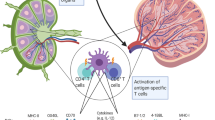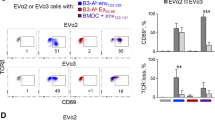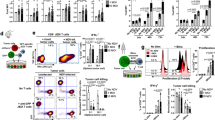Abstract
Dendritic cells (DC) are the most potent professional antigen-presenting cells with exquisite capacity to interact with T cells to initiate strong primary cellular immune responses. The antigen-presenting capability of DC makes them attractive vehicles for the delivery of therapeutic cancer vaccines. Recently, we have demonstrated that the introduction of a recombinant gene encoding the human Flt3L gene into mice could result in the expansion of the DC population in vivo. In this report, we have introduced the human Flt-3L gene via naked DNA-based immunization in combination with the muc-1 tumor peptide to immunize mice. We demonstrated that the population of DC expanded following stimulation with the human Flt-3L gene in vivo is functional and they are able to elicit potent muc-1 peptide-specific cellular responses. The strategy described here allows the efficient generation of antigen-specific CTL immunity in vivo and has the potential to be applied in developing efficient protocols for antigen-specific immunotherapy of human malignancies.
This is a preview of subscription content, access via your institution
Access options
Subscribe to this journal
Receive 12 print issues and online access
$259.00 per year
only $21.58 per issue
Buy this article
- Purchase on Springer Link
- Instant access to full article PDF
Prices may be subject to local taxes which are calculated during checkout










Similar content being viewed by others
References
Steinman RM, Pack M, Inaba K . Dendritic cells in the T-cell areas of lymphoid organs Immunol Rev 1997 156: 25–37
Pagila P, Chiodoni C, Rodolfo M, Colombo MP . Murine dendritic cells loaded in vitro with soluble protein prime cytotoxic T lymphocytes against tumor antigen in vivo J Exp Med 1996 183: 317–322
Celluzzi CM et al. Peptide-pulsed dendritic cells induce antigen-specific CTL-mediated protective tumor immunity J Exp Med 1996 183: 283–287
Nestle FO et al. Vaccination of melanoma patients with peptide- or tumor lysate-pulsed dendritic cells Nat Med 1998 21: 328–332
Yang S et al. Murine dendritic cells transfected with human GP100 elicit both antigen-specific CD8(+) and CD4(+) T-cell responses and are more effective than DNA vaccines at generating anti-tumor immunity Int J Cancer 1999 83: 532–540
Fong L et al. Dendritic cells injected via different routes induce immunity in cancer patients J Immunol 2001 166: 4254–4259
Austyn JM, Kupiec-Weglinski JW, Hankins DF, Morris PJ . Migration patterns of dendritic cells in the mouse. Homing to T cell-dependent areas of spleen, and binding within marginal zone J Exp Med 1988 167: 646–651
Maraskovsky E et al. Dramatic increases in the numbers of functionally mature dendritic cells in Flt-3 ligand-treated mice: multiple dendritic cell subpopulations identified J Exp Med 1996 184: 1953–1962
Lynch DH et al. Flt-3 ligand induces tumor regression and antitumor immune responses in vivo Nat Med 1997 3: 625–631
Esche C et al. Flt-3 ligand administration inhibits tumor growth in murine melanoma and lymphoma Cancer Res 1998 58: 380–383
Ardavin C, Wu L, Li CL, Shortman K . Thymic dendritic cells and T cells develop simultaneously in the thymus from a common precursor population Nature 1993 362: 761–763
Wu L, Li CL, Shortman K . Thymic dendritic cell precursors: relationship to the T lymphocyte lineage and phenotype of the dendritic cell progeny J Exp Med 1996 184: 903–911
Gary A, Travis M, Cen D, Chen B . Human T, B, natural killer and dendritic cells arise from a common bone marrow progenitor cell subset Immunity 1995 3: 459–473
Xiaofeng W et al. Regression of human mammary adenocarcinoma by systemic administration of a recombinant gene encoding the hFlex-trail fusion protein Mol Ther 2001 3: 368–374
Inaba KM et al. Generation of large numbers of dendritic cells from mouse bone marrow cultures supplemented with granulocyte/macrophage colony-stimulating factor J Exp Med 1992 176: 1693–1702
Liu F, Song YK, Liu D . Hydrodynamics-based transfection in animals by systemic administration of plasmid DNA Gene Therapy 1999 6: 1258–1266
Apostolopoulos V, McKenzie IFC . Cellular mucins: targets for immunotherapy Crit Rev Immunol 1996 14: 930–938
O'Garra A . Cytokines induce the development of functionally heterogeneous T helper cell subsets Immunity 1998 8: 275–283
Heufler C et al. Interleukin-12 is produced by dendritic cells and mediates T helper 1 development as well as interferon-(production by T helper cells Eur J Immunol 1996 26: 659–668
Sato M, Iwakabe K, Kimura S, Nishimura T . Functional skewing of bone marrow-derived dendritic cells by Th1- or Th2-inducing cytokines Immunol Lett 1999 67: 63–68
Denton G, Sekowski M, Price MR . Induction of antibody responses to breast carcinoma associated mucins using synthetic peptide constructs as immunogens Cancer Lett 1993 70: 143–150
Avichezer D, Taylor-Papadimitriou J, Arnon R . A short synthetic peptide (DTRPAP) induces anti-mucin (MUC-1) antibody, which is reactive with human ovarian and breast cancer cells Cancer Biochem Biophys 1998 16: 113–128
Braun SE et al. Flt3 ligand antitumor activity in a murine breast cancer model: a comparison with granulocyte–macrophage colony-stimulating factor and a potential mechanism of action Hum Gene Ther 1999 10: 2141–2151
Liu YJ . Dendritic cell subsets and lineages, and their functions in innate and adaptive immunity Cell 2001 106: 259–262
Ardavin C, Wu L, Li C-L, Shortman K . Thymic dendritic cells and T cells develop simultaneously in the thymus from a common precursor population Nature 1993 362: 761–763
Sauders D et al. Dendritic cell development in culture from thymic precursor cells in the absence of granulocyte/macrophage colony-stimulating factor J Exp Med 1996 184: 2185–2196
Henderson RA et al. Human dendritic cells genetically engineered to express high levels of the human epithelial tumor antigen mucin (MUC-1) Cancer Res 1996 56: 3763–3770
Pecher G, Finn OJ . Induction of cellular immunity in chimpanzees to human tumor-associated antigen mucin by vaccination with MUC-1 cDNA-transfected Epstein–Barr virus-immortalized autologous B cells Proc Natl Acad Sci USA 1996 93: 1699–1704
Apostolopoulos V, Pietersz GA, McKenzie FC . Cell-mediated immune responses to MUC1 fusion protein coupled to mannan Vaccine 1996 14: 930–938
Goydos JS et al. A phase I trial of a synthetic mucin peptide vaccine J Surg Res 1996 63: 298–304
Karanikas V et al. Antibody and T cell responses of patients with adenocarcinoma immunized with mannan-Muc-1 fusion protein J Clin Invest 1997 100: 2783–2792
Banchereau J, Steinman RM . Dendritic cells and the control of immunity Nature 1998 392: 245–252
Savary CA et al. Characteristics of human dendritic cells generated in a microgravity analog culture system In Vitro Cell Dev Biol Anim 2001 37: 216–222
Kotera Y et al. Humoral immunity against a tandem repeat epitope of human mucin MUC-1 in sera from breast, pancreatic, and colon cancer patients Cancer Res 1994 54: 2856–2860
Andersson E et al. A tandem repeat of MUC1 core protein induces a weak in vitro immune response in human B cells Cancer Immunol Immunother 1999 47: 249–256
Carbone FR, Moore MW, Sheil JM, Bevan MJ . Induction of cytotoxic T lymphocytes by primary in vitro stimulation with peptides J Exp Med 1998 167: 1767–1779
Lyman SD et al. Cloning of the human homologue of the murine flt-3 ligand: a growth factor for early hematopoietic progenitor cells Blood 1994 83: 2795–2801
Felgner JH et al. Enhanced gene delivery and mechanism studies with a novel series of cationic lipid formulations J Biol Chem 1994 269: 2550–2561
Taswell C . Limiting dilution assays for the determination of immunocompetent cell frequencies J Immunol 1981 126: 1614–1619
Fazekas DE, Groth ST . The evaluation of limiting dilution assays - review article J Immunol Meth 1984 49: 11–23
Lefkovis I, Waldmann H . Limiting dilution analysis of the cells of the immune system Immunol Today 1984 5: 265–272
Acknowledgements
This work was supported by grants from the National Medical Research Council of Singapore and the National Science and Technology Board, Singapore.
Author information
Authors and Affiliations
Rights and permissions
About this article
Cite this article
Fong, C., Hui, K. Generation of potent and specific cellular immune responses via in vivo stimulation of dendritic cells by pNGVL3-hFLex plasmid DNA and immunogenic peptides. Gene Ther 9, 1127–1138 (2002). https://doi.org/10.1038/sj.gt.3301783
Received:
Accepted:
Published:
Issue Date:
DOI: https://doi.org/10.1038/sj.gt.3301783
Keywords
This article is cited by
-
Nanosized bioceramic particles could function as efficient gene delivery vehicles with target specificity for the spleen
Gene Therapy (2007)
-
Coexpression of Flt3 ligand and GM-CSF genes modulates immune responses induced by HER2/neu DNA vaccine
Cancer Gene Therapy (2007)
-
Intramuscular immunization with plasmid coexpressing tumour antigen and Flt-3L results in potent tumour regression
Gene Therapy (2006)
-
Hydrodynamics-based gene delivery of naked DNA encoding fetal liver kinase-1 gene effectively suppresses the growth of pre-existing tumors
Cancer Gene Therapy (2006)
-
Murine mammary adenocarcinoma cells transfected with p53 and/or Flt3L induce antitumor immune responses
Cancer Gene Therapy (2005)



